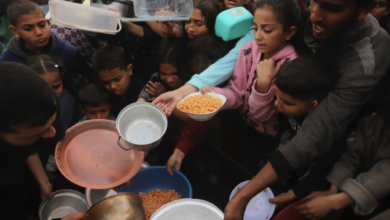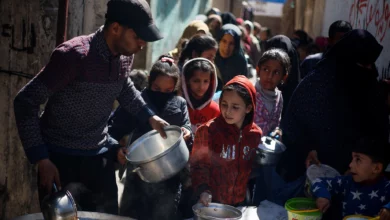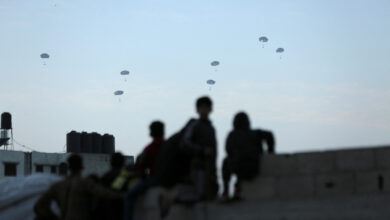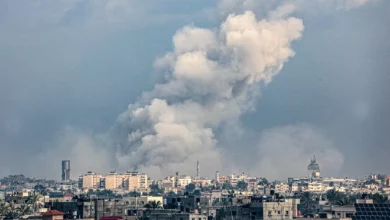NAIROBI, Kenya – The United Nations has begun airlifting food supplies to famine-struck Somalia, World Food Program head Josette Sheeran said during a crisis talk last week in Nairobi. Somali Foreign Minister Mohamed Ibrahim joined Sheeran in the talk, adding that more than 3.5 million people in his country are currently threatened by starvation.
The Horn of Africa is beset by one of the worst droughts in sixty years, according to a recently released UN report. The airlifts – the most recent landing on Friday in Mogadishu – provide much-needed relief to a population also reeling from persistent violence in areas of the country hardest hit by food shortages.
Analysts have so far labeled the relief effort sluggish and insufficient but the surging number of people that arrive daily in eastern Kenya’s Dadaab camp, the largest refugee camp in the world, is stimulating international humanitarian organizations to action.
''The drought, compounded by prevailing violence in southern and central parts of the country, is turning one of the world's worst humanitarian crises into a human tragedy of unimaginable proportions," said Melissa Fleming, a spokeswoman for United Nations High Commissioner for Refugees.
Al-Shabab, an Al-Qaeda linked militant organization that controls large swathes of the country including parts of the capital, continues to deny aid organizations access to zones affected by the crisis, however. The group claims the UN is spreading false information regarding the drought. Al-Shabab also routinely accuses aid organizations of espionage.
The fragile, Western-backed Somali government also suffers from inaccessibility to needy Somalis flowing into the capital. Gunfights with al-Shabab erupt frequently in Mogadishu and government forces largely stay away from strongholds of the militant group.
In anticipation of worsening times ahead, the Swedish embassy in Nairobi announced on Thursday a US$16 million aid package to Somalia. The Swedish government in 2011 has issued a total of US$50 million in aid to ravaged Somalia.
“There is an imminent risk that the famine in Somalia will spread during the next months,” Swedish ambassador to Kenya Ann Dismorr said. “Sweden is strongly committed to alleviate the humanitarian situation in the Horn of Africa.”
French officials on Monday said they are tripling aid to Somalia to US$43 million. But critics continue to urge other countries to meet their pledged support.
“It is shameful that only a few of the richest and powerful economies were willing to demonstrate…their commitment to saving the lives of many of the poorest and most vulnerable," director of the UK-based relief organization OXFAM, Barbara Stocking, said recently in Nairobi.
The World Bank reportedly vowed last week to provide nearly US$700 million in aid over the next five years to Horn of Africa countries affected by the crisis.
"Immediate relief and recovery is the first priority, and it is important to act fast to reduce human suffering," said World Bank President Robert B. Zoellick. "But we also have an eye on the long term solutions of economic recovery and drought resilience that are key to re-establishing livelihoods and ensuring that droughts don't take such a heavy human toll in the future."
Local and international humanitarian organizations claim foreign governments ignored warnings issued years ago of an impending crisis in the region. Critics also accuse aid organizations of failing to heed the call for the much-needed relief quickly. Relief organizations, moreover, have largely focused on immediate aid efforts rather than fostering sustainable food security, critics say.
But today aid from humanitarian organizations trickles in. The Central Emergency Response Fund (CERF), a UN-managed humanitarian fund, recently gave US$20 million to aid agencies and projects in Somalia, US$14.6 million to Ethiopia and US$13.6 million to Kenya.
Operations Director for Mission Aviation Fellowship (MAF) Kenya and South Sudan, Tim Vennell, said his organization has provided additional aircraft to respond to humanitarian needs in the region. He says MAF pilots, however, have so far been unable to fly into Somalia due to security concerns.
“The requests are starting to flow, but there’s still a reluctance…especially with al-Shabab making their statement just this week that they are not so keen on opening up,” Vennell said. “But there’s still a desire to move into that region.”
And relief organizations are effectively meeting some of the most immediate needs of the refugees flooding the camps on the Kenyan border. Operating out of Dadaab, the non-profit Doctors Without Borders (MSF) currently treats more than 2400 children in its ambulatory, therapy program. Those treated here are unable to walk due to severe malnutrition. Medical workers replenish their bodies with food and water through drip-systems. MSF administers the only hospital in Dagahaley, one branch of Dadaab. The facility has a total of only 170 beds.
Despite limited resources, however, aid agencies anticipate growing demand.
“More refugees are on their way,” says MSF nurse Nenna Arnold. “We are already at bursting point, but the figures keep growing. This situation is a humanitarian emergency.”
Arnold is in charge of monitoring the immediate health needs of the new arrivals, with the help of nearly 80 Somali medical workers. Every day, she and her team go into the camps and the surrounding areas to find people in need of medical treatment.
According to MSF’s Isoe-Nyachieng, however, the harrowing journey to traverse Somalia by foot is also having a severe psychological impact that medical workers are scrambling to treat.
“Many end up traumatized due to the exhausting journey in need of food and shelter that goes on for days,” he said. “They see a range of problems from depression and anxiety to schizophrenia, bipolar disorder and manic depression.”
Covering her face with a black veil, Fatima Abdi says her quest for food came with a particularly disturbing price. On the journey to Dadaab from the Somali interior, she was raped.
“I was among a group of girls who were ambushed by bandits on our way here,” she said. “We were too weak to run. We were attacked by men carrying weapons. We had to give in…”
Janet Ndoti-Ndila, a counselor for CARE International, says her organization speaks to more than 50 people daily in Dagahaley alone, offering post-traumatic counseling to those who, due to shame and other reasons, cannot turn to their family or friends for emotional support.
“If you tell one person about something, everybody in the community will know," she said. "So instead of being stigmatized and being discriminated, you decide not to tell anyone. You will be branded ‘the raped one’.”
Nyachieng says those allocating resources don’t prioritize such psychological suffering.
“Mental health has not been given the emphasis that it deserves," said Nyachieng. "If it can get the same coverage, like nutrition or malaria or HIV/AIDS, it could be better.”
Aid organizations and foreign governments appear to be increasingly mobilized today. But demand has skyrocketed and the plight of Somalis in country and seeking refuge in other parts of the region remains dire.
UNICEF officials on Friday said almost one-third of the nearly four million Somalis threatened by starvation are children. And most of those Somalis currently residing in Dadaab, where humanitarian relief is actually taking shape, lack access to water, shelter and other basic necessities.
“We’re overwhelmed,” said Ann Mugisha, a pediatric nurse with MSF.




